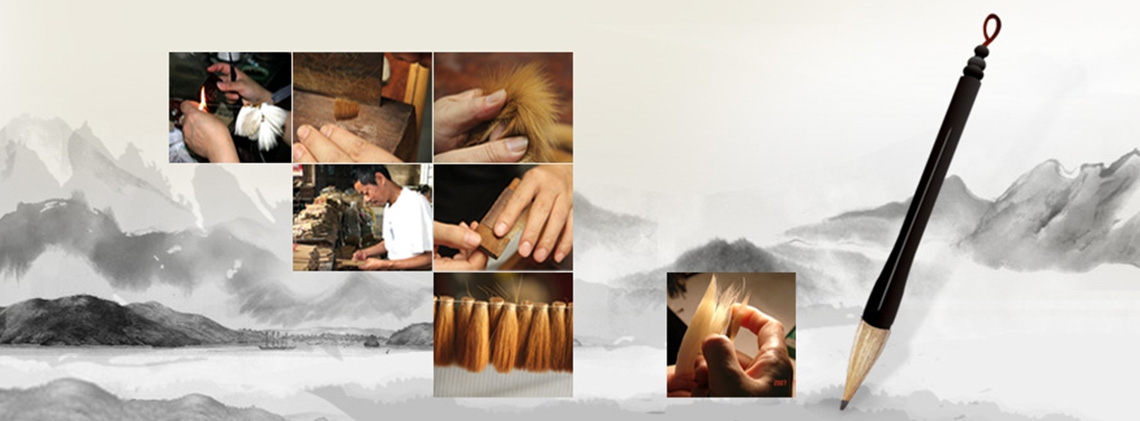
Traditional Techniques of Making Writing-Brush
Splendid
Chi Culture
Topic
Traditional Techniques of Making Writing-Brush
The writing brush has a long history—traces of its use have found on painted pottery from as long ago as the Neolithic. Before the Qin dynasty (221–206 BCE), the writing brush (bi) went by various names. However, when the Qin government implemented the policy for the “standardization of the writing system and the width of axles,” the names were put aside in favor of the word we use today. During the Han dynasty (206 BCE–220 CE), not only was attention paid to the quality of the writing tip, but to the overall appearance of the brush as well. During the Wei (220–265) and Jin (265–420) periods, Chinese calligraphy matured and with it the making of writing brushes did also. Manufacturing was standardized and a variety of brushes were made to meet the calligraphers’ needs.
Entering the High Tang era (ca. 713–765), professional workshops were set up to make writing brushes. The workshops in Xuanzhou (modern Xuancheng city, Anhui province) enjoyed a national reputation for the superior brushes they produced and sent as tribute every year to the imperial palace. They were called “Xuan brushes” on account of their origin. A number of innovations were made during the Song dynasty (960–1279). Such things as the shape of the brush, the materials used to make it, and even the way it was produced all became distinctive. Production of the Xuan brush declined during the Southern Song dynasty (1127–1279); however, the industry in Huzhou, Zhejiang province (an area bordering Xuanzhou) developed vigorously.
Huzhou laid a good foundation for the manufacture of writing brushes in the Ming dynasty (1368–1644). As overall developments in Chinese handicrafts were made, the Ming dynasty saw the production of brushes peak. The representative, top-quality writing instrument at this time was the Xuande brush.
Under the Qing dynasty (1644–1911), the manufacture of writing brushes reached its zenith. The Qianlong era (r. 1736–1795), like the Ming dynasty Xuande era (r. 1426–1435), was another hallmark year for writing brushes. The selection of materials, and the skills that went into their construction produced brushes that were as fine as any Xuande brush and could be called the Qianlong brush.
Entering the modern era, and influenced by the New Culture Movement, some people adopted the fashionable fountain pen. Despite this, most people led traditional lifestyles and continued using the writing brush. Shanlian township in Huzhou remained the production center for the Hu brush. Following the founding of the People’s Republic of China, local governments actively organized and restored the production of the Hu brush. This revitalization of a traditional brush-making center sparked a number of entrepreneurial developments. Many other places now began to produce superior writing brushes, such as the Xuan brush from Xuancheng of Anhui province, the shui brush from Yangzhou of Jiangsu province, the maolong brush from Xinhui of Guangdong province, and the brushes from Wen’gang of Jiangxi province.
Writing brushes are classified according to the size, the type of hair used in the tip, the place of origin, and their shapes. There are three major types of hair used: purple, goat, and wolf. Purple hair, which comes from wild rabbits, is a distinctive trait of the Xuan brush. The hair from mountain goats forms the majority of goat-hair tips; great attention is paid to its selection. The yellow-rat wolf (Siberian weasel) is the source of wolf’s hair. The traditional way of making brushes, which is quite fastidious and complex, continues on even today.
There are many grades of hair; the method of naming the hair can be divided into two main types: product name and commodity name. However, the product name is often further divided into several different commodity names. The main use of the writing-brush is for writing and painting; when writing and painting are elevated to the artistic realm, the artistic work is called calligraphy and painting. Thus, fulfilling the requirements of creating painting and calligraphy has always been the goal and evolutionary pattern pursued by the Hu brush-making technology.



